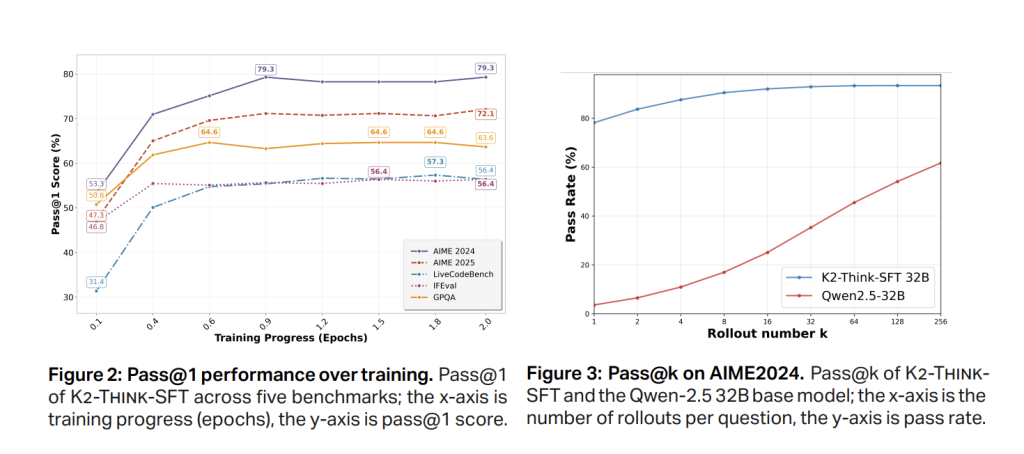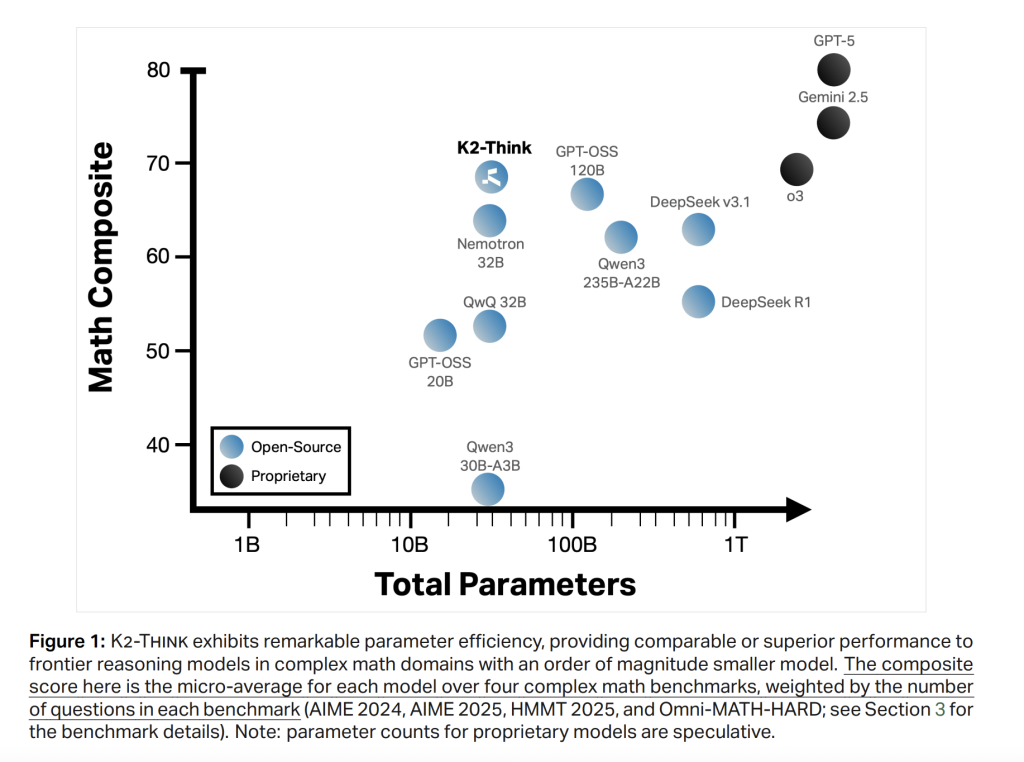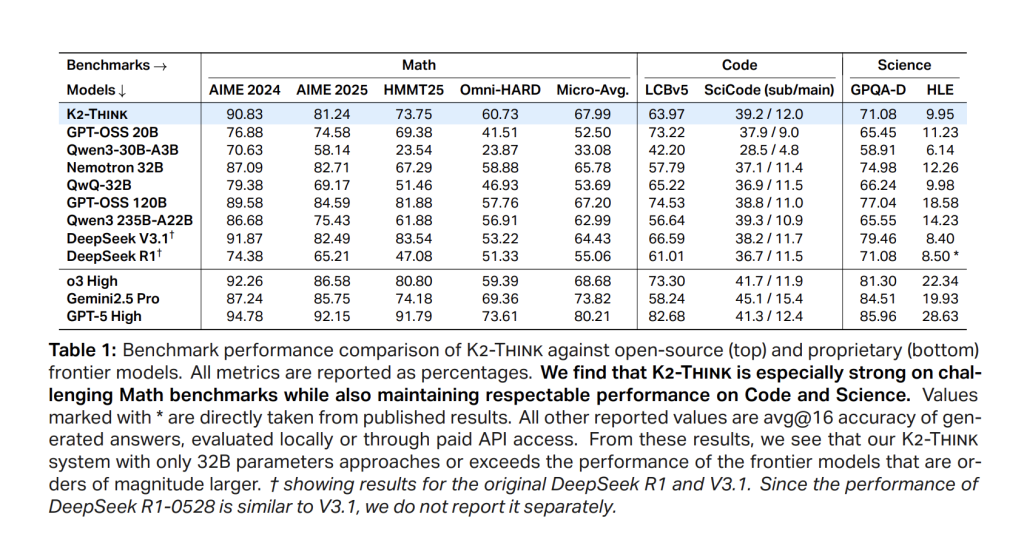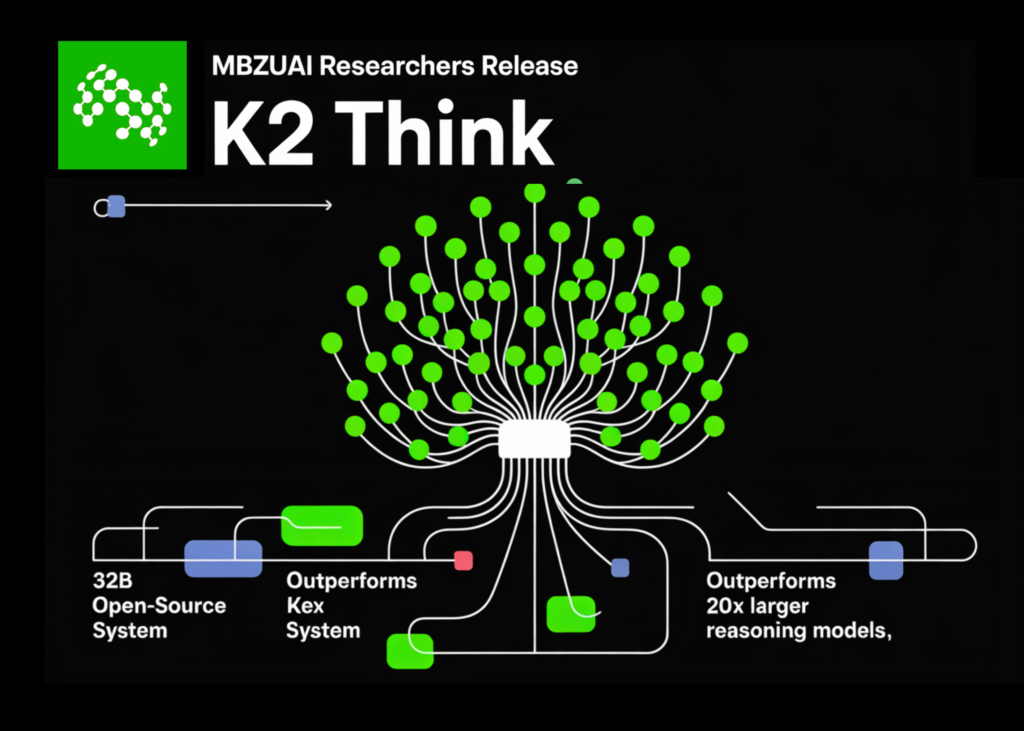A team of researchers from MBZUAI’s Institute of Foundation Models and G42 released K2 Think, is a 32B-parameter open reasoning system for advanced AI reasoning. It pairs long chain-of-thought supervised fine-tuning with reinforcement learning from verifiable rewards, agentic planning, test-time scaling, and inference optimizations (speculative decoding + wafer-scale hardware). The result is frontier-level math performance with markedly lower parameter count and competitive results on code and science—together with a transparent, fully open release spanning weights, data, and code.
System overview
K2 Think is built by post-training an open-weight Qwen2.5-32B base model and adding a lightweight test-time compute scaffold. The design emphasizes parameter efficiency: a 32B backbone is deliberately chosen to enable fast iteration and deployment while leaving headroom for post-training gains. The core recipe combines six “pillars”: (1) Long chain-of-thought (CoT) supervised fine-tuning; (2) Reinforcement Learning with Verifiable Rewards (RLVR); (3) agentic planning before solving; (4) test-time scaling via best-of-N selection with verifiers; (5) speculative decoding; and (6) inference on a wafer-scale engine.
The goals are straightforward: raise pass@1 on competition-grade math benchmarks, maintain strong code/science performance, and keep response length and wall-clock latency under control through plan-before-you-think prompting and hardware-aware inference.
Pillar 1: Long CoT SFT
Phase-1 SFT uses curated, long chain-of-thought traces and instruction/response pairs spanning math, code, science, instruction following, and general chat (AM-Thinking-v1-Distilled). The effect is to teach the base model to externalize intermediate reasoning and adopt a structured output format. Rapid pass@1 gains occur early (≈0.5 epoch), with AIME’24 stabilizing around ~79% and AIME’25 around ~72% on the SFT checkpoint before RL, indicating convergence.
Pillar 2: RL with Verifiable Rewards
K2 Think then trains with RLVR on Guru, a ~92k-prompt, six-domain dataset (Math, Code, Science, Logic, Simulation, Tabular) designed for verifiable end-to-end correctness. The implementation uses the verl library with a GRPO-style policy-gradient algorithm. Notable observation: starting RL from a strong SFT checkpoint yields modest absolute gains and can plateau/degenerate, whereas applying the same RL recipe directly on the base model shows large relative improvements (e.g., ~40% on AIME’24 over training), supporting a trade-off between SFT strength and RL headroom.
A second ablation shows multi-stage RL with a reduced initial context window (e.g., 16k → 32k) underperforms—failing to recover the SFT baseline—suggesting that reducing max sequence length below the SFT regime can disrupt learned reasoning patterns.
Pillars 3–4: Agentic “Plan-Before-You-Think” and Test-time Scaling
At inference, the system first elicits a compact plan before generating a full solution, then performs best-of-N (e.g., N=3) sampling with verifiers to select the most likely-correct answer. Two effects are reported: (i) consistent quality gains from the combined scaffold; and (ii) shorter final responses despite the added plan—average token counts drop across benchmarks, with reductions up to ~11.7% (e.g., Omni-HARD), and overall lengths comparable to much larger open models. This matters for both latency and cost.
Table-level analysis shows K2 Think’s response lengths are shorter than Qwen3-235B-A22B and in the same range as GPT-OSS-120B on math; after adding plan-before-you-think and verifiers, K2 Think’s average tokens fall versus its own post-training checkpoint (e.g., AIME’24 −6.7%, AIME’25 −3.9%, HMMT25 −7.2%, Omni-HARD −11.7%, LCBv5 −10.5%, GPQA-D −2.1%).
Pillars 5–6: Speculative decoding and wafer-scale inference
K2 Think targets Cerebras Wafer-Scale Engine inference with speculative decoding, advertising per-request throughput upwards of 2,000 tokens/sec, which makes the test-time scaffold practical for production and research loops. The hardware-aware inference path is a central part of the release and aligns with the system’s “small-but-fast” philosophy.

Evaluation protocol
Benchmarking covers competition-level math (AIME’24, AIME’25, HMMT’25, Omni-MATH-HARD), code (LiveCodeBench v5; SciCode sub/main), and science knowledge/reasoning (GPQA-Diamond; HLE). The research team reports a standardized setup: max generation length 64k tokens, temperature 1.0, top-p 0.95, stop marker , and each score as an average of 16 independent pass@1 evaluations to reduce run-to-run variance.


Results
Math (micro-average across AIME’24/’25, HMMT25, Omni-HARD). K2 Think reaches 67.99, leading the open-weight cohort and comparing favorably even to much larger systems; it posts 90.83 (AIME’24), 81.24 (AIME’25), 73.75 (HMMT25), and 60.73 on Omni-HARD—the latter being the most difficult split. The positioning is consistent with strong parameter efficiency relative to DeepSeek V3.1 (671B) and GPT-OSS-120B (120B).
Code. LiveCodeBench v5 score is 63.97, exceeding similarly sized peers and even larger open models (e.g., > Qwen3-235B-A22B at 56.64). On SciCode, K2 Think is 39.2/12.0 (sub/main), tracking the best open systems closely on sub-problem accuracy.
Science. GPQA-Diamond reaches 71.08; HLE is 9.95. The model is not just a math specialist: it stays competitive across knowledge-heavy tasks.




Key numbers at a glance
- Backbone: Qwen2.5-32B (open weight), post-trained with long CoT SFT + RLVR (GRPO via verl).
- RL data: Guru (~92k prompts) across Math/Code/Science/Logic/Simulation/Tabular.
- Inference scaffold: Plan-before-you-think + BoN with verifiers; shorter outputs (e.g., −11.7% tokens on Omni-HARD) at higher accuracy.
- Throughput target: ~2,000 tok/s on Cerebras WSE with speculative decoding.
- Math micro-avg: 67.99 (AIME’24 90.83, AIME’25 81.24, HMMT’25 73.75, Omni-HARD 60.73).
- Code/Science: LCBv5 63.97; SciCode 39.2/12.0; GPQA-D 71.08; HLE 9.95.
- Safety-4 macro: 0.75 (Refusal 0.83, Conv. Robustness 0.89, Cybersecurity 0.56, Jailbreak 0.72).
Summary
K2 Think demonstrates that integrative post-training + test-time compute + hardware-aware inference can close much of the gap to larger, proprietary reasoning systems. At 32B, it is tractable to fine-tune and serve; with plan-before-you-think and BoN-with-verifiers, it controls token budgets; with speculative decoding on wafer-scale hardware, it reaches ~2k tok/s per request. K2 Think is presented as a fully open system—weights, training data, deployment code, and test-time optimization code.
Check out the Paper, Model on Hugging Face, GitHub and Direct Access. Feel free to check out our GitHub Page for Tutorials, Codes and Notebooks. Also, feel free to follow us on Twitter and don’t forget to join our 100k+ ML SubReddit and Subscribe to our Newsletter.
Asif Razzaq is the CEO of Marktechpost Media Inc.. As a visionary entrepreneur and engineer, Asif is committed to harnessing the potential of Artificial Intelligence for social good. His most recent endeavor is the launch of an Artificial Intelligence Media Platform, Marktechpost, which stands out for its in-depth coverage of machine learning and deep learning news that is both technically sound and easily understandable by a wide audience. The platform boasts of over 2 million monthly views, illustrating its popularity among audiences.

